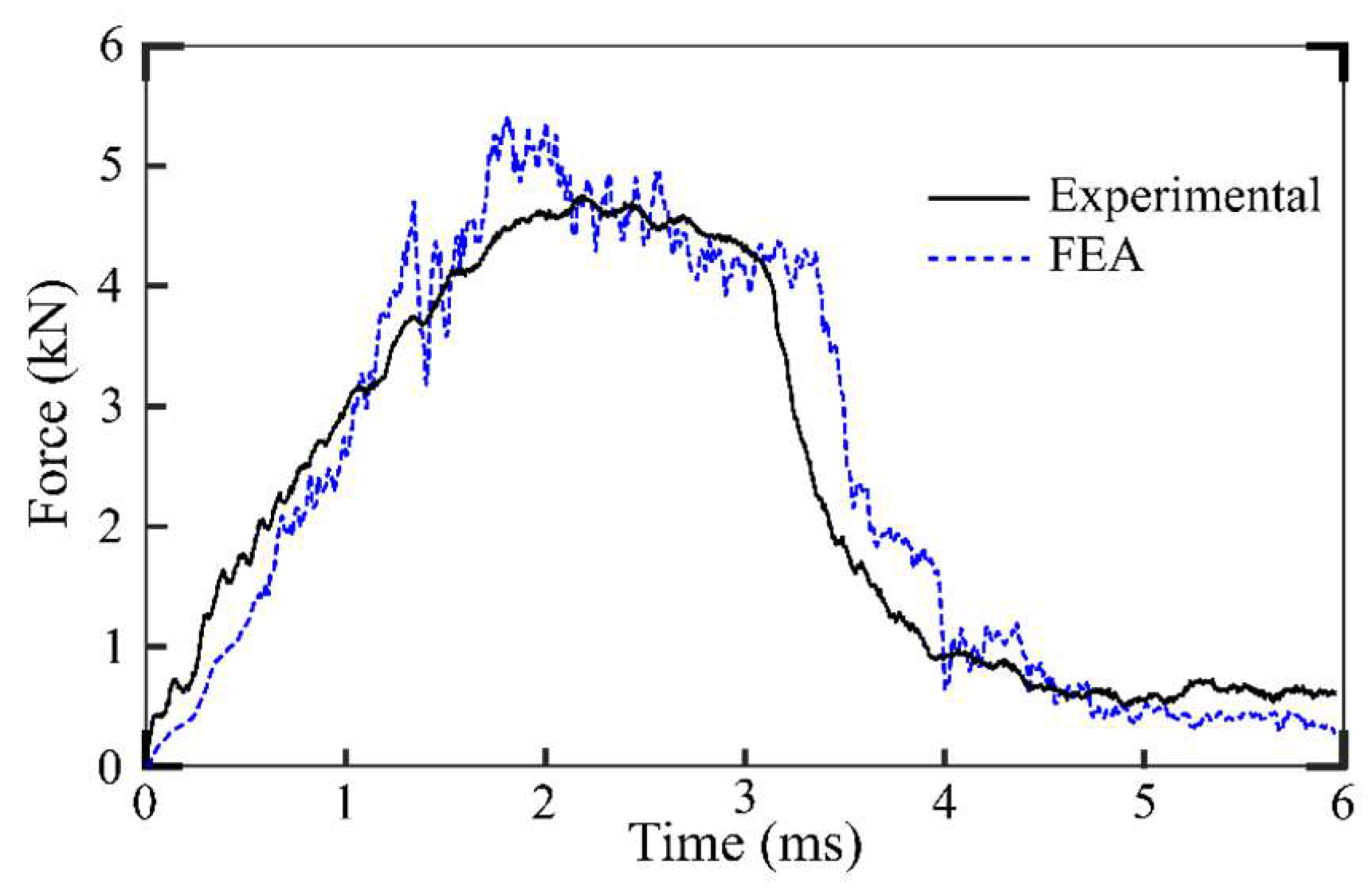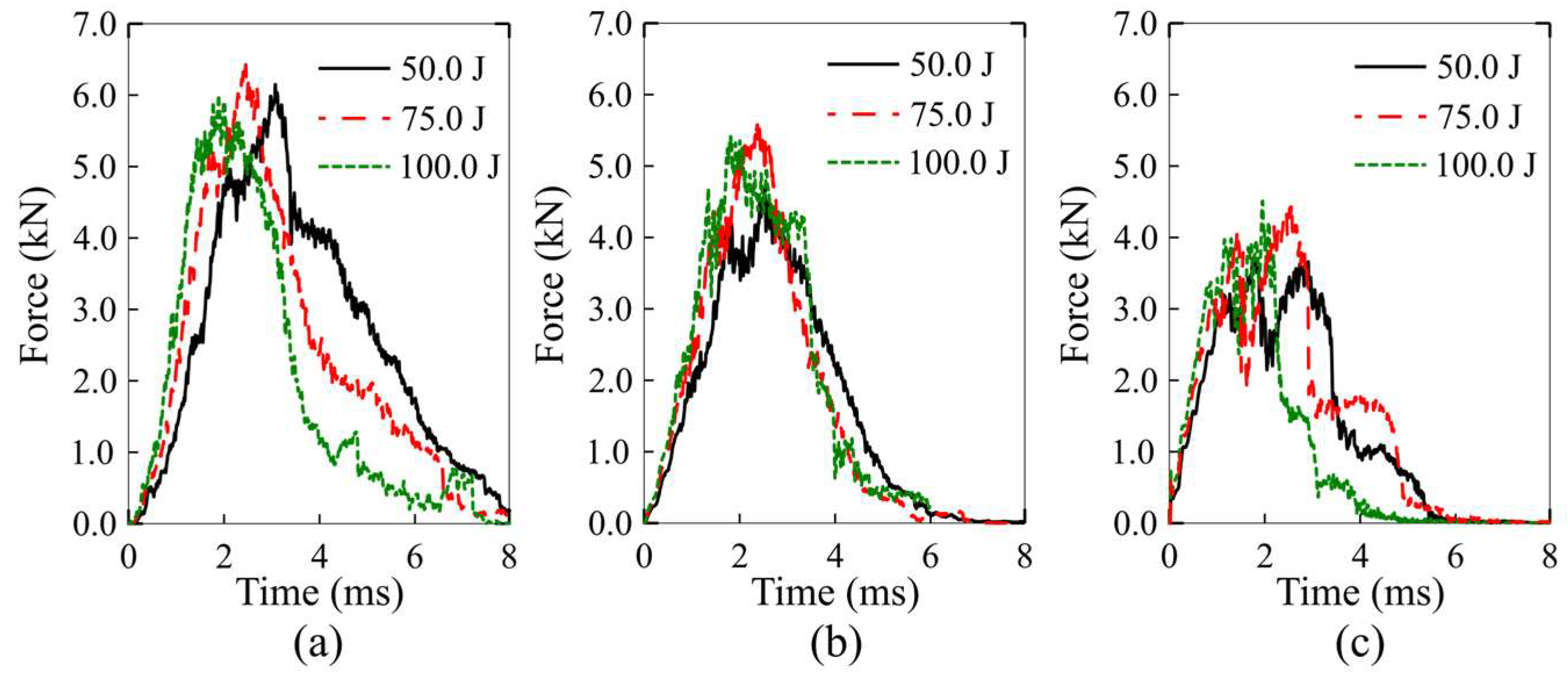Performance of Fish Scale-Inspired Armour Subjected to Impact Loading by Different Impactor Shapes: A Numerical Investigation †
Abstract
1. Introduction
2. Material and Methods
3. Results and Discussion
3.1. Result Validation
3.2. Force Histories and Energy Absorption
3.3. Stress Field
4. Conclusions
- During elastic deformation (approximately up to 2 ms), increases in the impact energy resulted in higher energy absorption for all the impactor shapes;
- For the perforated cases, the hemispherical indenter was the only shape of impactor that resulted in a positive correlation between the impact energy and the energy absorbed;
- Progressive cracks on the bottom surface were first seen with a flat-head impactor, whereas the sharp impactor pierced the specimen with a minimal damage area;
- The energy (internal + kinetic) absorbed by non-eroding elements was highest when impacted by the conical impactor. A longer contact duration and a gradual failure of the elements led to higher energy absorption.
Author Contributions
Funding
Institutional Review Board Statement
Informed Consent Statement
Data Availability Statement
Acknowledgments
Conflicts of Interest
References
- Duro-Royo, J.; Zolotovsky, K.; Mogas-Soldevila, L.; Varshney, S.; Oxman, N.; Boyce, M.C.; Ortiz, C. MetaMesh: A hierarchical computational model for design and fabrication of biomimetic armored surfaces. Comput.-Aided Des. 2015, 60, 14–27. [Google Scholar] [CrossRef]
- Browning, A.; Ortiz, C.; Boyce, M.C. Mechanics of composite elasmoid fish scale assemblies and their bioinspired analogues. J. Mech. Behav. Biomed. Mater. 2013, 19, 75–86. [Google Scholar] [CrossRef] [PubMed]
- Rudykh, S.; Boyce, M. Analysis of elasmoid fish imbricated layered scale-tissue systems and their bio-inspired analogues at finite strains and bending. IMA J. Appl. Math. 2014, 79, 830–847. [Google Scholar] [CrossRef]
- Rudykh, S.; Ortiz, C.; Boyce, M.C. Flexibility and protection by design: Imbricated hybrid microstructures of bio-inspired armor. Soft Matter 2015, 11, 2547–2554. [Google Scholar] [CrossRef] [PubMed]
- Martini, R.; Barthelat, F. Stretch-and-release fabrication, testing and optimization of a flexible ceramic armor inspired from fish scales. Bioinspir. Biomim. 2016, 11, 066001. [Google Scholar] [CrossRef] [PubMed]
- Dura, H.B.; Hazell, P.J.; Wang, H.; Escobedo-Diaz, J.P.; Wang, J. Energy absorption of composite 3D-printed fish scale inspired protective structures subjected to low velocity impact. Compos. Sci. Technol. 2024, 255, 110725. [Google Scholar] [CrossRef]
- Chintapalli, R.K.; Mirkhalaf, M.; Dastjerdi, A.K.; Barthelat, F. Fabrication, testing and modeling of a new flexible armor inspired from natural fish scales and osteoderms. Bioinspir. Biomim. 2014, 9, 036005. [Google Scholar] [CrossRef] [PubMed]
- Martini, R.; Balit, Y.; Barthelat, F. A comparative study of bio-inspired protective scales using 3D printing and mechanical testing. Acta Biomater. 2017, 55, 360–372. [Google Scholar] [CrossRef] [PubMed]
- Yazdani Sarvestani, H.; Mirkhalaf, M.; Akbarzadeh, A.H.; Backman, D.; Genest, M.; Ashrafi, B. Multilayered architectured ceramic panels with weak interfaces: Energy absorption and multi-hit capabilities. Mater. Des. 2019, 167, 107627. [Google Scholar] [CrossRef]
- Zhang, C.; Rawat, P.; Liu, P.; Zhu, D. A new design and performance optimization of bio-inspired flexible protective equipment. Bioinspir. Biomim. 2020, 15, 066003. [Google Scholar] [CrossRef] [PubMed]
- Shafiei, A.; Barthelat, F. 3D mechanics of scaled membranes. Int. J. Solids Struct. 2022, 241, 111498. [Google Scholar] [CrossRef]
- Islam, M.A.; Kader, M.A.; Hazell, P.J.; Escobedo, J.P.; Brown, A.D.; Saadatfar, M. Effects of impactor shape on the deformation and energy absorption of closed cell aluminium foams under low velocity impact. Mater. Des. 2020, 191, 108599. [Google Scholar] [CrossRef]
- Bahadur Dura, H.; Hazell, P.J.; Wang, H.; Escobedo-Diaz, J.P. Effect of scale morphology on the mechanical response of bio-inspired fish-scale-based protective structures. Compos. Part A Appl. Sci. Manuf. 2023, 174, 107720. [Google Scholar] [CrossRef]
- Siddique, S.H.; Hazell, P.J.; Pereira, G.G.; Wang, H.; Escobedo, J.P.; Ameri, A.A.H. On the Mechanical Behaviour of Biomimetic Cornstalk-Inspired Lightweight Structures. Biomimetics 2023, 8, 92. [Google Scholar] [CrossRef] [PubMed]
- Hallquist, J.O. LS-DYNA(R) Theory Manual; Livermore Software Technology Corporation: Livermore, CA, USA, 2006. [Google Scholar]
- UltiMaker. UltiMaker Material Technical and Safety Data Sheets. 2024. Available online: https://support.ultimaker.com/s/article/1667337600364 (accessed on 18 February 2025).
- Yahiaoui, M.; Denape, J.; Paris, J.Y.; Ural, A.G.; Alcalá, N.; Martínez, F.J. Wear dynamics of a TPU/steel contact under reciprocal sliding. Wear 2014, 315, 103–114. [Google Scholar] [CrossRef]
- Kumar, S.; Saha Roy, B. Tribological properties of acrylonitrile butadiene styrene in self–mated contacts and against steel disc. Mater. Today Proc. 2020, 26, 2388–2394. [Google Scholar] [CrossRef]
- Hazell, P.J. Armour: Materials, Theory, and Design, 2nd ed.; CRC Press: Boca Raton, FL, USA, 2022. [Google Scholar]





| Properties | Tissue | TPU | Scale | ABS |
|---|---|---|
| Density (kg/m3) | 1210 | 1070 |
| Elastic modulus (MPa) | 56.7 | 1998 |
| Poisson’s ratio | 0.49 | 0.35 |
| C [s−1], P (for Cowper–Symonds equation) | 971, 0.98 | 678, 3.23 |
Disclaimer/Publisher’s Note: The statements, opinions and data contained in all publications are solely those of the individual author(s) and contributor(s) and not of MDPI and/or the editor(s). MDPI and/or the editor(s) disclaim responsibility for any injury to people or property resulting from any ideas, methods, instructions or products referred to in the content. |
© 2025 by the authors. Licensee MDPI, Basel, Switzerland. This article is an open access article distributed under the terms and conditions of the Creative Commons Attribution (CC BY) license (https://creativecommons.org/licenses/by/4.0/).
Share and Cite
Dura, H.B.; Hazell, P.J.; Wang, H. Performance of Fish Scale-Inspired Armour Subjected to Impact Loading by Different Impactor Shapes: A Numerical Investigation. Mater. Proc. 2025, 20, 4. https://doi.org/10.3390/materproc2025020004
Dura HB, Hazell PJ, Wang H. Performance of Fish Scale-Inspired Armour Subjected to Impact Loading by Different Impactor Shapes: A Numerical Investigation. Materials Proceedings. 2025; 20(1):4. https://doi.org/10.3390/materproc2025020004
Chicago/Turabian StyleDura, Hari Bahadur, Paul J. Hazell, and Hongxu Wang. 2025. "Performance of Fish Scale-Inspired Armour Subjected to Impact Loading by Different Impactor Shapes: A Numerical Investigation" Materials Proceedings 20, no. 1: 4. https://doi.org/10.3390/materproc2025020004
APA StyleDura, H. B., Hazell, P. J., & Wang, H. (2025). Performance of Fish Scale-Inspired Armour Subjected to Impact Loading by Different Impactor Shapes: A Numerical Investigation. Materials Proceedings, 20(1), 4. https://doi.org/10.3390/materproc2025020004







